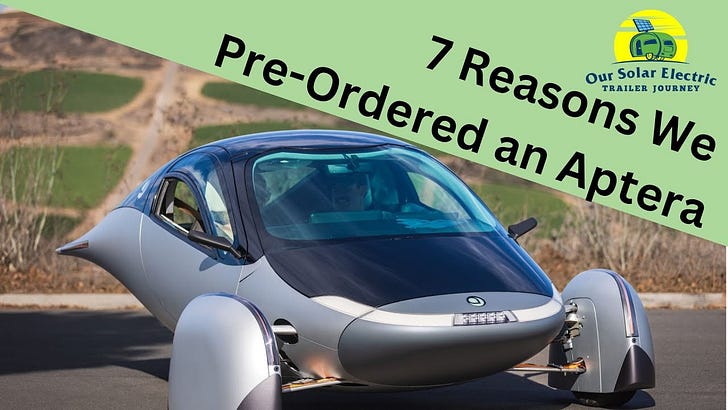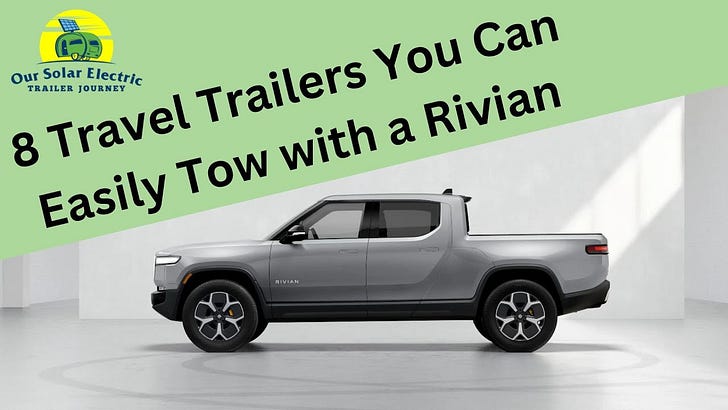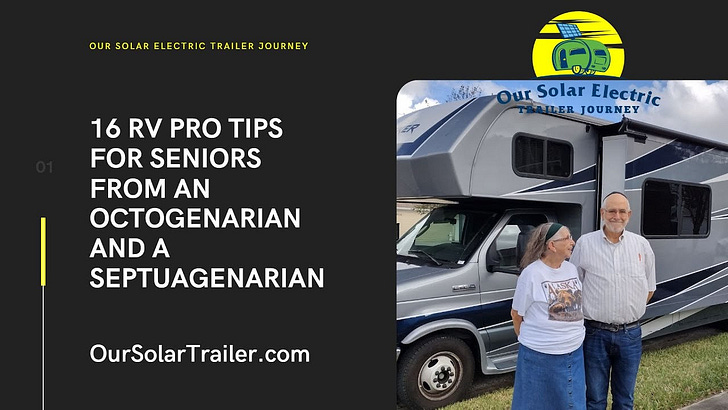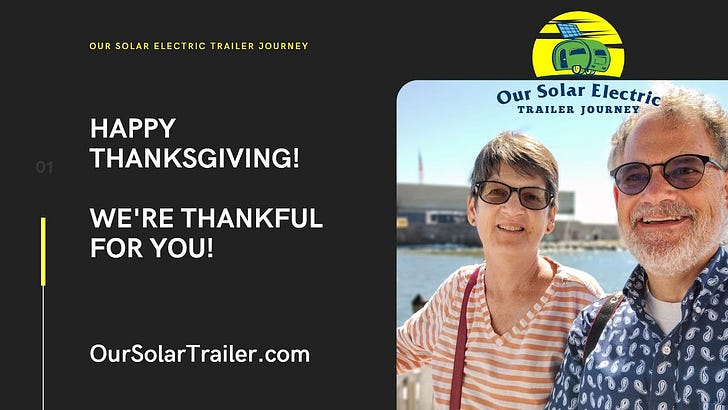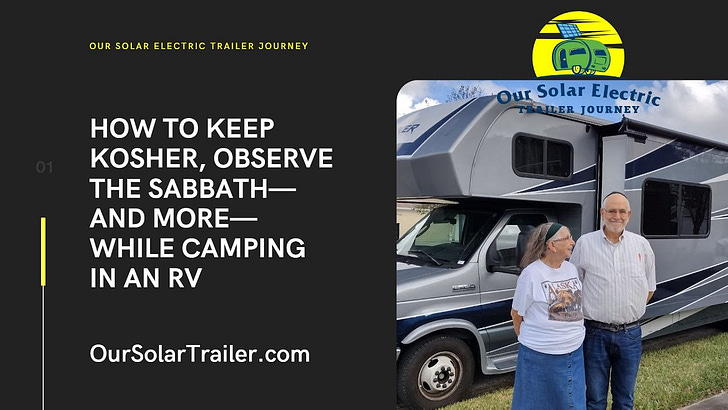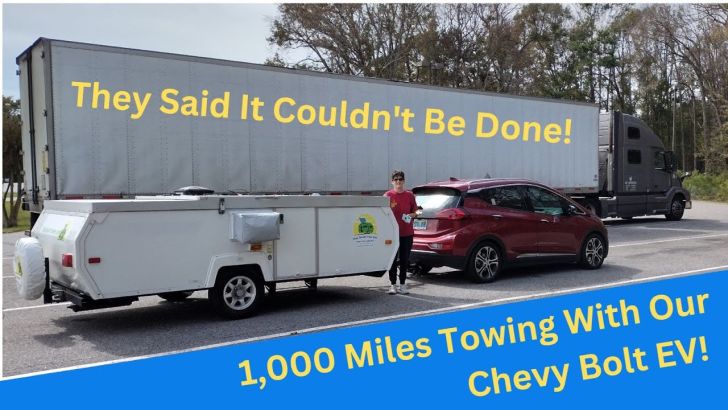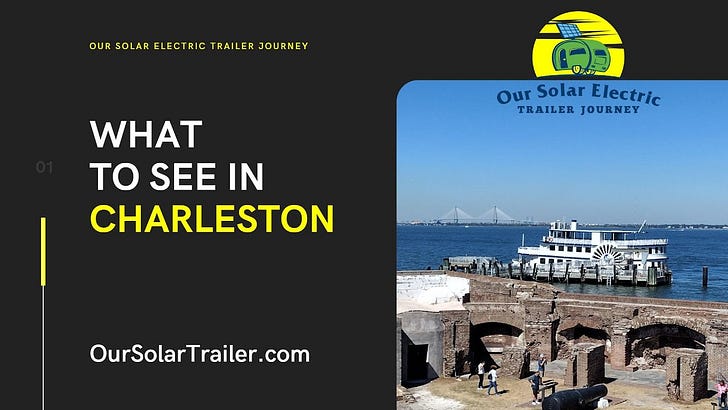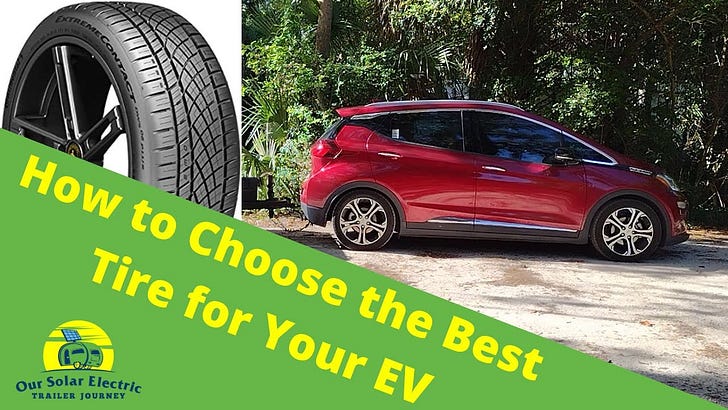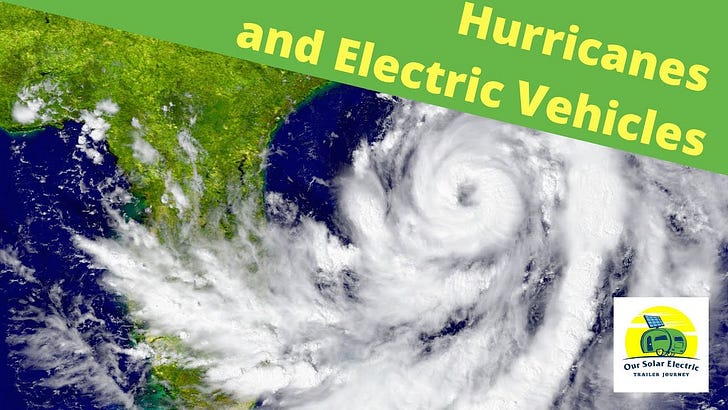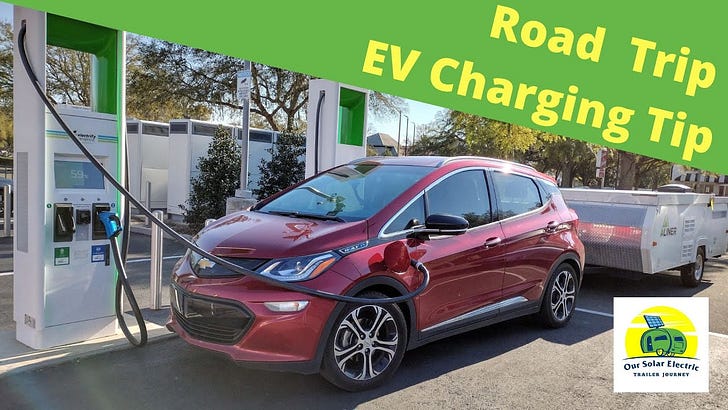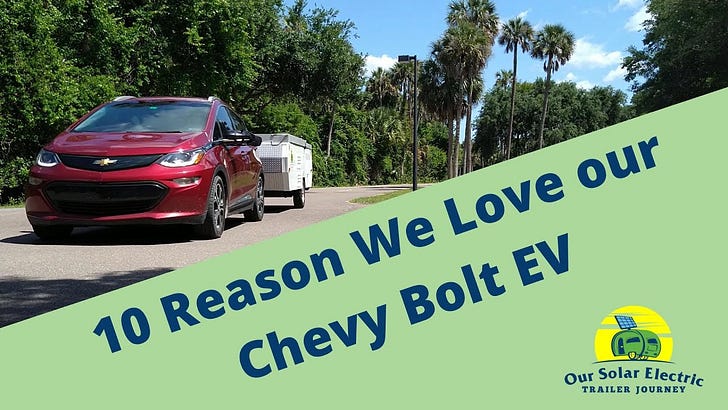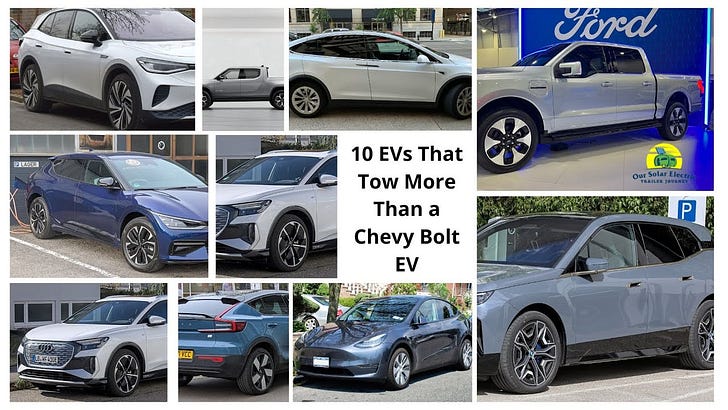Discover Our Solar Electric Trailer Journey
Our Solar Electric Trailer Journey

Our Solar Electric Trailer Journey
Author: Devin and Gail Thorpe
Subscribed: 2Played: 59Subscribe
Share
© Devin and Gail Thorpe
Description
Follow our journey as we buy a Rivian R1T electric truck to pull a travel trailer equipped to run exclusively on solar power!
oursolarelectrictrailer.substack.com
oursolarelectrictrailer.substack.com
57 Episodes
Reverse
We’ve just returned from our latest—and for many purposes—our last camping trip in the Aliner Scout. This is our farewell.Eighteen months ago, we launched “Our Solar Electric Trailer Journey” with a grand vision of buying an electric truck, probably a Rivian, to two a trailer we’d equip with solar power. We still don’t have a truck, and the latest estimate for when one will arrive is still months in the future.We didn’t let this stop us. We bought an Aliner Scout camper we could tow with our Chevy Bolt EV. We added solar panels and a 200 amp-hour, 2.5 kWh lithium battery, along with a top-of-the-line inverter/charger and charge controller. After months of research and education, we installed the panels, battery and all the rest ourselves.Along the way, we shared our journey with you, including our many woes. We hope the challenges and problems we faced helped you or someone else to avoid some of the pain we experienced.The pinnacle of our journey was a 1,000-mile trip we made towing our little RV with our little ev along the southeastern coast of the United States from Florida to North Carolina and back. What a blast!On that trip, we were able to go five out of seven days without plugging in the trailer, operating on solar and battery power. And plenty of people told us it couldn’t be done!While we won’t be posting here any longer, you can follow Devin’s podcast and newsletter here.We’ll genuinely miss you. We’ve loved building relationships in the real world, from random folks we’ve met at charging stations who share what they’ve learned from our videos to our podcast and YouTube friends who’ve invited us to be guests on their shows. We’ll miss you all.Thank you for the kindness, support and patience you’ve shown us. We’ve learned a great deal from you!Now, good luck on your solar electric trailer journey, whatever it may be to you!P.S. The Aliner is now for sale. This is a public episode. If you would like to discuss this with other subscribers or get access to bonus episodes, visit oursolarelectrictrailer.substack.com
We are excited to report that our little Aliner Camper is back in business!You may recall that a blowout left our rig out of the game. We were surprised by how long it took to get the little popup camper trailer back in service.Here’s a recap of what has taken so long.Step 1: InsuranceWe were pleasantly surprised by how quickly State Farm received our claim and processed it, sending us an estimate of the cash required to cover the repair, net of our deductible. That entire process took only a week.Step 2: Find Someone to Do the RepairsIt took about three weeks for us to find someone willing and able to do the repairs. One challenge for us was that there are no Aliner dealers in our area. Not only wasn’t there a dealer with a repair shop we could automatically call, few of the repair shops around were familiar with Aliners or interested in the sort of repair we needed.Step 3: Find PartsOf course, finding parts wasn’t our job, it fell to the team that agreed to do the repairs. Not having done much Aliner work, they didn’t have a good supply chain in place for those parts. It took about a month for them to get the parts ordered and then another month for the parts to arrive.Step 4: Get Permission From the HOAThe next challenge, with parts in hand, was to schedule the work. We hadn’t fully appreciated when we found a team willing and able to do the work that they didn’t have a facility to do the repairs. Their plan was to use our driveway. Our HOA didn’t think that was a good plan, so we had to apply for a waiver of the rules. That application process pushed the repair out another month. The HOA was gracious and quickly approved the plan.Step 5: Do the RepairsLast week, in our driveway, the team did the repair. They did a great job cutting out about 10 percent of the floor of the trailer and replacing it. They sealed everything up good and tight. Critically, they took out all the solar power electrictronics and put it all back in. Not surprisingly, it looks like they did a better job than we had done as novices.Next Step: Go Camping!With our trailer repaired, we’re planning a little excursion for next weekend! This is a public episode. If you would like to discuss this with other subscribers or get access to bonus episodes, visit oursolarelectrictrailer.substack.com
When you purchase an item after clicking a link from this post, we may earn a commission.We haven’t talked much about the Aptera we’ve pre-ordered, so we thought we’d use our newsletter, podcast and YouTube show this week to explain the seven reasons we pre-ordered one of these solar-powered EVs.The Aptera is a solar-powered, three-wheeled vehicle enclosed like a car (so you’ll frequently catch us calling it a car) but regulated more like a motorcycle.Reason #1: Extreme EfficiencyWe expect the Aptera to be the most efficient vehicle on the road. With 10 miles per kWh of range, the little EV will be 2.5 times more efficient than our Bolt and five times more efficient than the Rivian electric pickup we’ve ordered.Reason #2: George Jetson StyleDevin says the first thing that came to mind when he saw a photo of an Aptera was George Jetson’s flying car. It is that spacey! We love that! We get that not everyone wants a car that attention-grabbing, but we do. We want to be talking to people about energy efficiency, solar power and Our Solar Electric Trailer Journey.Even with our Chevy Bolt, we are frequently stopped by people curious about EVs. We can’t wait to drive the Aptera!Reason #3: Solar PanelsThe solar panels on the Aptera can provide up to 40 miles per day of driving! To get that, you’ll need to upgrade from the base model’s limited solar panel coverage to get the whole vehicle covered with solar.With that upgrade, you could get 10,000 miles (theoretically even more) of free electricity from the sun every year! It is hard to imagine.Reason #4: The Incredible RangeWe’ve pre-ordered the 600-mile range version of the Aptera. The longest-range option will run 1,000 miles on a single charge! Production will begin, the company says, with the 400-mile range option and then move to the 250-mile battery.The batteries in the Apteras don’t appear to be designed for super fast charging, but that may come. For now, the company promises 40 to 60 kW fast charging (about the same as our Bolt). Keep in mind, however, that given the vehicle’s efficiency, it will be charging 2.5 times faster than the Bolt in terms of miles per minute.At this rate, the Aptera should be capable of adding 100 miles of range in ten minutes!Reason #5: AffordabilityThe Aptera starts at an almost unbelievable price of just $25,900. The version we pre-ordered with all-wheel drive, the full solar package and 600 miles of range still comes in under $40k.That is an excellent price for a car that doesn’t require charging for routine, around-town driving or even short road trips. Reason #6: SpeedWith the all-wheel drive package, the Aptera will have a 0-60 time of just 4 seconds. That’s fast.We think of our Bolt as fast with its 7.2 second 0-60 speed. We can’t wait to put the hammer down in the little Aptera!Reason #7: We’re InvestedAptera is raising money via investment crowdfunding. We invested shortly after we pre-ordered the vehicle. Today, you can invest as little as $210 via the crowdfunding site Republic.Let’s be clear about a couple of things here. We’re biased. Aptera can’t make our car until it raises more money. We want people to invest. We’re not financial advisors. Don’t invest because we did!So, there you have the seven reasons we’re excited to have pre-ordered an Aptera!Do you need a hook on the garage wall for your EV charging cable? This one might work.If you’re interested in investing in companies that help address climate change, you may wish to learn more at SuperCrowd23. Subscribers get 50 percent off! This is a public episode. If you would like to discuss this with other subscribers or get access to bonus episodes, visit oursolarelectrictrailer.substack.com
Last week, we attended the Florida RV Supershow in Tampa for the second time. What a blast! We exhausted ourselves roaming the show occupying the entire Florida State Fairgrounds, climbing in and out of dozens of travel trailers.We left with a list of 13 RVs we’d consider towing with our Rivian R1T when it arrives this summer. We want a trailer that is in that sweet spot for towing range (weight) and comfort (size). The smaller the trailer, the farther we can go. The bigger the trailer, the farther we want to go. Here’s more of our analysis.We’ve narrowed the list down to eight models with floorplans and features we like.Here’s our list, showing dry (unloaded) weight and length.We anticipate that the fully loaded weight of the trailer will be about 2,000 pounds more than the dry weight. We’ll review them in this order, from lightest to heaviest.Gulf Stream Vintage Cruiser 23RSSDevin’s favorite is the smallest trailer that made the cut—not entirely for that reason. The Gulf Stream Vintage Cruiser 23RSS is styled inside and out with a retro feel that Devin loves. The bathroom divides the bedroom from the rest of the living space. It does lack a feature we both want—theater seating.Venture Sonic 231VRLGail’s favorite, perhaps she’d call it a reluctant favorite, is the next up on the list in terms of weight. The floor plan does an even better job than the Vintage Cruiser of using the bathroom to divide the trailer into three private rooms, which is important when we need quiet for work or when we have house guests. Like the Vintage Cruiser, it lacks theater seating.Forest River Rockwood Mini Lite 2104SThe Forest River Rockwood Mini Lite 2104S is the shortest trailer on the list. With a murphy bed and good-sized slide-out, the trailer feels roomier than we’d otherwise expect. The short trailer would be more maneuverable, too. There is a theater seating option that eliminates other beds for guests or when Gail makes Devin sleep on the sofa.JayCo Jay Feather 21 MMLThe JayCo trailer offers theater seating, a dinette and a sofa/murphy bed set up. Still relatively small among the trailers on our list, we see how this one could work for us. The open floor plan creates a sense of spaciousness but doesn’t provide anywhere to have privacy.Keystone RV Passport SL 229RKThe distinctive feature about this floorplan is the bona fide wall and doors between the bedroom and the rest of the trailer. It has an option for theater seating that we love. Cruiser RV Shadow Cruiser 228RKSThe Shadow Cruiser 228RKS is similar to the last trailer but lacks the wall and has a curtain for bedroom privacy. It does come standard with the theater seating we love.Twilight RVs Twilight Signature TW2280The Twilight RVs Twilight Signature is the only one in the size range we found with a king-size bed. That’s pretty compelling. It also has theater seating but privacy is limited to a curtain around the bedroom.Grand Design Imagine XLS 23LDEThe heaviest and longest trailer on our list, it is the only one with two doors—one in the bedroom and one in the kitchen. It features theater seating and maximum privacy with a big bathroom dividing the trailer.We’re not sure which of these we’ll get. Almost certainly, we’ll find a fairly new but used model so we can use the savings to install the solar panels and battery storage we want.You can help us decide. In the comments, please answer any of the following questions we have for you:* Which is your favorite?* Which would you pick for us?* What else besides weight, length and theater seating should we consider?* Does weight correlate with durability?* Does weight correlate with insulation?We’re excited to get your feedback before the Rivian arrives and we hit the road! This is a public episode. If you would like to discuss this with other subscribers or get access to bonus episodes, visit oursolarelectrictrailer.substack.com
When you purchase an item after clicking a link from this post, we may earn a commission.Recently, we had an experience that will serve as a powerful object lesson for you. While traveling to southwestern Florida to help with recovery efforts following Hurricane Ian, a tire on our Aliner Scout blew out. We’ll not only share the surprisingly bad story but also some tips for avoiding this fate.The Devastating BlowoutDevin made the trip alone to join a group of volunteers from our church helping people recover after the storm. About halfway, while passing through suburban Orlando, a passenger in a passing car signaled to Devin that something was wrong.He pulled over to discover the driver’s side trailer had blown. There were few real challenges changing the tire and getting underway. Within an hour, Devin was back on the road. He called Gail to report the problem noting, “It could have been much worse.”Upon arriving in Port Charlotte where he “camped” in a church parking lot, he set up the trailer and discovered it was much worse.It was a rainy day and there was water inside the trailer. The electrical system wouldn’t work at all to power anything. A quick investigation yielded the truth: The blowout did serious damage to the trailer, including large holes in the floor of the cabinet with almost all the electronics.Everything inside the cabinet was wet; there was debris from the road and from the tire inside. It was a mess.“I was despondent,” Devin said afterward.The following day was dry. While Devin worked with the volunteers, the trailer sat in the warm sun drying out. That evening, Devin tried the electrical system and found it operational. Looking back, Devin admits the first sign of trouble came an hour before the blowout. He picked up a vibration coming from the trailer that he correctly judged to be a problem with a tire. He stopped to check it out at a rest stop but couldn’t see a problem. Nervously, he proceeded—a choice he now regrets.The trailer is currently out of service and awaiting repairs. It is difficult to get the necessary parts, like the replacement wheel well destroyed by the blowout. While insurance will cover some costs, new tires would have been much cheaper than our deductible.How You Can Avoid the Same FateWhile there are no absolute guarantees you can avoid a blowout, there are three keys to avoiding one. Two are common knowledge but one we believe is important is rarely considered.* Tire Pressure. Always check the air pressure in the tires before every trip. We are diligent about this and confident that this wasn’t a factor in our little disaster. Improper air pressure is, however, the leading cause of blowouts—especially under inflation, which increases stress on the tire causing failure at freeway speeds.* Tread. When a tire is worn out from too many miles, easily seen in the tread, it is more vulnerable to blowing out. Our trailer is fairly old but had seen little use. The tread on the tires appeared virtually new. The tread itself was not the cause of our blowout.* Age. Our tires weren’t worn out, but they were old. For nearly a decade, they lived outside holding a trailer. They didn’t have many miles, but they’d lived too long in service. We considered replacing them but put it off, another decision we regret. So keep in mind these three simple tips:* Always check the tire pressure.* Check the tread wear before every trip.* Replace the tires every 4 or 5 years even if treadwear doesn’t require it.By following these simple steps you like (likely) avoid the sort of disaster we experienced. This is a public episode. If you would like to discuss this with other subscribers or get access to bonus episodes, visit oursolarelectrictrailer.substack.com
When you purchase an item after clicking a link from this post, we may earn a commission.The Aliner Scout A-frame popup trailer roof features four springs, two on each side. The springs make lifting the roof easy. One of our springs broke. We replaced both springs on that side. This is how we did it.With one spring broken, the Aliner folks recommend discontinuing the use of the RV.This project scared us. Aliner recommends having it done by a professional. When opening the roof without the bungee cords attached, you can do catastrophic damage to the camper.To prevent that, you’ll want to open the rig next to your garage or other structure that will block the wind or gravity from grabbing the roof and overextending the hinges.Before you can do that, you have to disconnect the bungee cords. Do this simply by removing the caulk that hides the screws holding the bungee. Then remove the screws. Save them to reattach the cords.Before opening the roof, we’d recommend taping the loose bungee cords to the top of the roof to keep them out of the way.The springs are mounted in holes in the front and back walls of the trailer. The other end of the spring is inside a sleeve about five inches long mounted on the aluminum frame of the roof/ceiling.To remove the springs, you just remove the sleeve and then pull the spring out of the hole. To remove the sleeve, which is attached with rivets, just drill out the rivets. Pulling the springs out of their holes takes only a minute or two of tugging with some enthusiasm.Getting the replacement springs in the hole takes a bit more time and finesse. We found a rubber mallet helpful. Before you remove the old ones, take a careful look at how they are seated so you can put the replacements in the same place.Once the spring is in position, you can slip the sleeve back into place and use rivets to secure it just the way you found it. We fastened these rivets with this rivet gun.With the springs installed, you now need to reattach the bungee cords. The key is to create some slack at the end of the cords so you have maximum flexibility and ease. I used a clamp like this one.With the end of the bungee hanging slack, you can now easily use the same screws and caps to reattach the bungee cords in the same place they were originally attached. Be sure to squire plenty of caulk under the caps before tightening the screws. Don’t over-tighten! Then be sure to add more caulk over the screws and around the cap to ensure a good seal.That’s it. It really is about as easy as that sounds. Below is the video we found from Rick at Going Nowhere Fast that is helpful. I’d only note that you can save some steps he needed simply by getting the right rivets. Again, these worked.If you have tips or questions, please leave them in the comments. We love hearing from you. This is a public episode. If you would like to discuss this with other subscribers or get access to bonus episodes, visit oursolarelectrictrailer.substack.com
When you purchase an item after clicking a link from this post, we may earn a commission.Shopping for gifts for RVers can be challenging. We’ve created an eclectic list of things that weight and power-conscious RVers—in other words, most RVers—will use and appreciate.Everything we’re adding to the list we own and use and recommend based on our experience. A few links we’ll provide are to items like ours but not the same make and model.By the way, we’re saving the best for last! Check out number 11.We know you’re—that is, Santa is—busy, so we’ll get right to it.* Katchy Indoor Insect Trap. This currently $35 item is nearly silent and uses low power. It attracts bugs with dim light, sucks them in with a fan and then traps them on sticky paper. It can operate off USB power; you could power it with your USB backup battery, even in a tent! We love that it works so well and draws so little energy out of our solar-powered battery.* Kindle Fire. Devin’s been using his 7-inch Kindle Fire for nearly a decade. He loves having it on camping trips. Lightweight and drawing little power, he can use it for hours to read, surf the web, check Twitter, watch Netflix, Hulu, Amazon Prime, and so much more. The new 8-inch model has an HD screen, more storage and a faster processor, all for just $55 (at the moment).* Small USB Desk Fan. This little guy is mostly about saving energy by avoiding the use of the air conditioner. There are times when it is just too hot to rely on a fan alone, but when temps are in the upper 70s at night, a little breeze can be just enough relief to save power and the noise of the air conditioner. You may want one of these $15 items for everyone in the RV to have their own!* Electric Blanket. Based in Florida, we’re not doing any cold-weather camping. On cool evenings, we use electric blankets to stay warm rather than using a space heater. Blankets use much less power than a furnace of any sort and, in mild weather, can keep you comfy-cozy while sleeping. When you’re in the rig when it’s cold in the daytime, using it as a lap blanket can make the chill tolerable.* Collapsible Storage Bins. We bought these bins because they fit perfectly into some of the cupboards in our trailer. We love them because they collapse into a tiny fraction of their volume for storing them when we’re not using them.* National Park Annual Pass. We’re glad we qualify for the senior lifetime pass. For years before we did, we bought annual passes. They make great gifts. (The NPS doesn’t allow gifting for the senior pass.)* 50 States, 5,000 Ideas: Where to Go, When to Go, What to See, What to Do. This isn’t just a great reference book for planning trips but is readable, cover to cover! We’re excited to use it for planning our 2023 trips.* VacLife Handheld Vacuum. We bought this to help us clean up the RV after working on it. We’ve loved it for that purpose, but also for use in the car and even in some spots in the house we can’t reach with a conventional vacuum. It is excellent for quick cleanups anywhere!* Ozark-Trail Folding Wagon. You see folding wagons everywhere. Once we got one, we figured out why. They are unbeatable for hauling stuff. You'll want one if you ever need to transport anything while camping! (We found a much better deal at Walmart.)* GOOLOO Foldable 100W Solar Panel. You know, we’re all about the solar panels. We’ve got 500 Watts of solar on our tiny RV. We love it. This portable solar panel is a great introduction to solar for folks who don’t have any. It pairs well with item number 11.* Portable Power Jump Starter. We received our unit as a gift. We use it all the time. We use it on every single RV trip. It has saved our bacon a few times! We won’t camp without it. We couldn’t find our unit online, but we did find this Dewalt unit with all the same features.Those are our gift ideas for 2022. If you have gift ideas, please share them in the comments. Let’s help each other find great gifts!The holidays are rich with meaning and significance for all of us. Giving the perfect gift is a great way to tell your loved ones how much they mean to you.You mean the world to us. We send our love. Merry Christmas! Happy Chanukah! Blessed Kwanza! We wish you a wonderful New Year’s celebration and a prosperous 2023. This is a public episode. If you would like to discuss this with other subscribers or get access to bonus episodes, visit oursolarelectrictrailer.substack.com
When you purchase an item after clicking a link from this post, we may earn a commission.Hilde (81) and Jay (76) Meyer started camping in a tent 50 years ago but quickly migrated to an RV. Though they didn’t maintain a rig for all those years, last year, they acquired a new Sunseeker Class C motorhome by Forest River.Their first trips allowed them to visit many of the lower 48 states, traveling from Florida through Texas to visit Utah’s five National Parks. Upon returning from that trip, they quickly tackled a trip to New England. Since completing those incredible journies, they’ve stayed closer to home, but continue camping regularly. Today, we’re excited to share their 16 RV pro tips for seniors:Tips:* Recognize your limitations. As we age, we need to acknowledge the limitations we face. For most seniors, this won’t prevent camping; it will require greater planning and preparation to enjoy the experience.* Avoid dirt. By parking on cement pads in nicer RV parks or by placing a big mat outside your RV parked on a dirt or gravel surface, you can keep dirt out of the RV, reducing the time spent cleaning.* Remember, camping is safe. Generally, people are on their best behavior in campgrounds. In well-chosen campgrounds, it is often safe to leave your gear outside unsupervised.* Check out Recreation Plantation. Hilde and Jay have a favorite campground, Recreation Plantation, in Lady Lake, Florida. It is a 55+ RV resort offering day, week, month, and 6&6 contracts. The 6&6 contracts are for snowbirds who want to spend half the year in Florida and the other half somewhere else, presumably up north.* Camp with people your age. In general, Hilde and Jay recommend finding 55+ campgrounds where all the guests are similarly situated. Many offer programming tuned to the interests of the silver-haired crowd. * Use the towed car for storage. For those driving motor homes, you can use your towed car for storing gear, including outdoor gear that may never need to go inside the RV.* Stay longer in each place and drive less. As we age, we need to adjust the balance between travel and rest, meaning we need to stay longer in each place we go. Unpack when you arrive, stay, and pack up. Jay jokes this is possible only after visiting Inspiration Point in Bryce Canyon National Park.* Attach a screen to your RV canopy: Jay and Hilde found someone to make a custom screen for their RV to get protection from the sun. Other vendors sell wrap-around screens that create outdoor living spaces protected from bugs, like the one below.* Get a griddle for outdoor cooking. A griddle can be a simpler way to cook outside than toting a large barbecue grill. They come in both gas and electric versions.* Limit travel range. As we age, it is important to manage your travel in accordance with your health needs and related factors. Hilde and Jay now keep their travel within about 150 miles of home.* Take your car with a tow dolly. If you tow a car, Jay and Hilde recommend using a tow dolly like the one displayed here. Most cars aren’t designed to be towed without one. It also has all the required lights, potentially simplifying the task of towing.* Have someone guide you as you drive the car onto the tow dolly. To avoid a disaster, have a spouse or friend guide you as you drive the car onto the tow dolly.* Get a trailer dolly for the tow dolly. Moving a 600-pound tow dolly around the garage or campsite can be tough the older we get. A trailer dolly like the one displayed below can help you move a trailer. We use one like this to easily move our 1,500-pound Aliner Scout around the garage.* Develop a new sense of defensive driving. Driving an RV is different from driving a car. The weight, stopping distance, height, and turning radius are all different. Add to that, our slowing reflexes and the need to be extra cautious is clear. This highly-rated book offers a guide.* Check your ability to do RV stairs. Motor home and travel trailer steps are often larger than the stairs in your home. Before you buy a rig, be sure you are comfortable with the steps. You may want to get a handrail or add a step on the ground for your rig to make access easier.* Split duties in and out of the RV while cooking outdoors. To avoid repeated trips up and down the RV steps while grilling outside, one of you should stay inside the rig while the other cooks outside. This allows you to pass items up and down the stairs to one another without traipsing up and down every time.Certainly, there is more to RV camping as seniors than this list, but if you’re human, you’ll find more of these ideas feel relevant the older you get. We’re grateful to Hilde and Jay for sharing their insights with us.If you have additional tips for seniors, please be sure to add them in the comments! This is a public episode. If you would like to discuss this with other subscribers or get access to bonus episodes, visit oursolarelectrictrailer.substack.com
Today, we want to express our deep gratitude and appreciation for you, our friends, family and followers who watch, listen and read our weekly message. We love sharing a message and are so grateful that so many of you tune in. Thank you!We’re also grateful for all those who drive electric vehicles. Driving zero-emission vehicles contributes to better urban air quality. Given that we enjoy breathing and love so many others addicted to at as well, we appreciate those who drive EVs. Thank you!We’re also grateful for innovators making exciting new electric vehicles and putting solar panels and other new tech on RVs. We are excited to get our new EVs over the next few years and can’t wait for January’s RV Supershow.We’d love to hear from you! What are you thankful for?Happy Thanksgiving! This is a public episode. If you would like to discuss this with other subscribers or get access to bonus episodes, visit oursolarelectrictrailer.substack.com
When you purchase an item after clicking a link from this post, we may earn an affiliate commission.Our friends Jay and Hilda Meyer live just down the street from us. As members of the Orthodox Jewish community, they keep kosher strictly, even when camping in their RV. They shared insights with us about following their faith and observing the Sabbath.Keeping KosherMost gentiles are familiar with kosher basics like avoiding pork, but may not appreciate all that keeping kosher requires.For instance, food and its containers must be keep meat and dairy strictly separate. Plates, pots and silverware is used only for meat (including anything with meat) or only for dairy (including anything with dairy). Food that contains neither, including eggs, grains, fruits and vegetables, is neutral or “pareve.”Hilda labels every drawer and cupboard in the RV with a D, M or P. All of the items are dedicated to use with only corresponding food.“I have to do a lot of planning,” Hilde says. “I have recipes about that deep [holding her hands to suggest a foot-tall stack] on a single page where I bring with me so that I can cook whatever we need.”“I'm lucky that I have a two-well sink so that I can use one for dairy, one for meat,” she adds. The strict separation means that dairy and meat are never served at the same meal. She can clean up from a meal using only the correct side of the sink.“I have three burners so I can make whatever I need to here,” she says of her stove. She has color-coded handles on the implements she uses to cook. “Blue is dairy, green is pareve and the red is meat.”Hilde and Jay have two toaster ovens. One for cooking meat dishes and one for dairy. “We're now all the time carrying dairy and meat, so we just switch them out,” Jay says. “The cab-over serves as a storage area for the bigger appliances.”Hilde keeps the kitchen linens separate. “I have separate wash cloths, dishcloths dish towels. So, I wash my items, whatever is dirty, dry them and put them away right away so that I don't have to worry about mixing anything up.”“For people to keep a kosher home, this, I think, is not as difficult as it sounds to the uninitiated because they're already living the experience,” Jay says. “All they're doing is transferring to a much smaller venue and learning to adjust and go without when necessary.”Keeping kosher begins with buying kosher food. “There are hundreds and hundreds and hundreds of kosher products on almost every grocery shelf,” Jay says. “You don't know it, but we know it because they carry little symbols that we look for.”“Kosher meat is very expensive,” Jay says. “They're not found in a lot of supermarkets that are situated in an area where they don't have a Jewish population because the meats are more expensive and people, if they're not Jewish, they would just walk by when they see the prices.”“We take whatever we can for frozen foods and we work down that inventory,” Jay says. They stock up when they “get to an area where we think there might be a kosher section in a supermarket.”Sabbath ObservanceObserving an orthodox Shabot, Shabbos or Sabbath may seem complicated to other folks, but habits, priorities and patterns allow Hilde and Jay to take it in stride.“There are electric restrictions, electricity restrictions,” Jay says. “The restrictions make people think that we live in the dark. We don't live in the dark. The restriction is that you cannot initiate electricity, you can't flip a switch.”“Liquids create a problem on the Sabbath,” he says. :If they're cold, we have rules where you really can't take a cold liquid and put it into a hot crockpot because that can be construed as cooking.”The secret is to start cooking before the Sabbath. “If you put it in before the Sabbath starts and you let it sit overnight, that's fine,” Jay says. “We do this all the time.”That guides what they eat on the Sabbath. “I don't use milk-based soup or cream-based soup because 36 hours is too long for that to sit,” Hilde says. “A lot of soups I can put in the crock pot.”“In the summer, I make a lot of salads like macaroni salad or something like that,” she adds.“We have a bread called challah,” Hilde says. “I make that usually once a month and we use three rolls and I make rolls because a whole loaf of bread is too much for the two of us.”They keep the Sabbath and the rest of their religious observance even on the road in their Sunseeker motor home. “There's a lot of sanctification to bread and to wine, all of which we take with us,” Jay says.“A lot of these units, ours included, have two motion sensors, a motion sensor on the step by the door and a motion sensor on the floor in the bathroom,” he says. “At night, it would activate that. We can't do that on the Sabbath.”Jay has a solution. “To alleviate that problem, I just cover it with tinfoil and masking tape. Then it doesn't go on.”Another strategy for Sabbath observance is their strategy for hot water. “We have a big urn,” Jay says. You always have plenty of hot water. So and that goes from before sunset, Friday till after sunset Saturday.”“At the conclusion of the Sabbath, we have the evening service. It's called Havdalah,” he says. “It's a ceremony that lasts two, three, four minutes where we light candle. We say prayer. We have wine. We say a prayer and we have spices. We say a prayer. They all have significance.”“When we're done with that, the Sabbath is over,” he concludes.Mezuzah“Mezuzah is a Hebrew word, translated into English means door post,” Jay says. “So, it says in the Bible that you should put this on your door post of your home.”“Some people think it's a good luck charm,” he says. “It isn't a sign intended to be good luck. It's a reminder that we have a Jewish home. It's a reminder that we have a creator higher than us and that this is not our house; it's his. And we need to behave and act accordingly in our lives. So we put that on the door.”The mezuzah contains a small scroll of animal parchment on which scripture has been handwritten.After planning some long trips, Jay found vital guidance. “If you're going to live in this [RV] for more than 30 days, you are required to have a mezuzah on the door.” This is a public episode. If you would like to discuss this with other subscribers or get access to bonus episodes, visit oursolarelectrictrailer.substack.com
When you purchase an item after clicking a link from this post, we may earn an affiliate commission.From the moment we installed the solar power system in our Aliner Scout camper, we experienced a problem we didn’t fully understand. On the sunniest days, the system would quit generating power!The problem seemed to be in the charge controller. We purchased and installed the Victron Energy Smart Solar MPPT 100 volt, 20 amp charge controller. At 100 volts and 20 amps, the little $159 (as of this writing) has a theoretical capacity of 2 kW—quite a bit of power. That limit is enough to power our air conditioner and refrigerator with power to spare. Recognizing we neither had room for that much solar on our trailer nor needed so much, we installed just 25 percent of that limit or 500 watts of solar. We naively assumed it would be adequate.Watts = Volts x AmpsA friend, Barry Lindler, who has a solar setup on his RV, warned us that the little charge controller might not be up to the job. We quickly determined that we couldn’t run the panels in parallel because the amperage would exceed the 20 amp limit on the controller, but concluded that for the 12-volt system, we could easily run five panels under the 100-volt limit running them in series.Connected in parallel, the amperage of the panels piles up, and the voltage remains consistent with one panel. Connected in series, the amperage remains consistent with one panel, and the voltage piles up. So five panels that produce 20 volts and 5 amps could be wired in parallel to produce 20 volts and 25 amps or in series to produce 100 volts and 5 amps—yielding 500 watts in either case.We were wrong! A YouTube follower with the handle CreepyCharly explained the problem after viewing the solar unboxing video we recorded in May. (If only he’d watched it in May!) The panels are designed to produce 17 volts (not 12) because charging the battery requires producing at least five more volts than the battery produces. The 17 volts represent a floor. The range tops 20 volts. So, with five panels on a sunny day, the voltage exceeds the 100-volt capacity of the charge controller.So, as we said up top, on the sunniest days, our charge controller shut down, and the system produced no power. With CreepyCharly’s explanation, we now understand why.We replaced the little charge controller with a bigger one, the Victron Energy BlueSolar MPPT 150 volt 35 amp one, for nearly twice the price of the smaller one. With 150 volts and 35 amps, the charge controller has a theoretical limit of 5.25 kW! Carefully configuring solar panels in series and parallel (grouping panels in series with the groups in parallel), I think you could come much closer to that limit than we did with our 500-watt (.5 kW) system.When we say it’s bigger, we mean literally bigger. Although it is still a pretty small device, about six by eight by three inches, it is about four times the size of the little one. That meant we couldn’t put the new charge controller where the old one was.We had to find a new spot and run longer wires inelegantly back across some of the other components of the system to connect to the solar input and the battery output. Our system wasn’t Instagram-worthy before, but we’ll definitely be keeping our baby out of public view now!We got the new charge controller just before Hurricane Ian hit Florida. We worked late into the evening before the storm hit to get our trailer ready so we could have a source of emergency power if the power went out.Luckily, we were unscathed by the storm and never lost power. Devin has spent two weekends volunteering to help with recovery efforts in Southwest Florida since. We’ll have more to share about that in coming weeks.When you purchase a charge controller for your RV solar power system, you’ll want to shop carefully to ensure you’ve got all the capacity you need for the sunniest days. You don’t want that sunlight going to waste! This is a public episode. If you would like to discuss this with other subscribers or get access to bonus episodes, visit oursolarelectrictrailer.substack.com
When you purchase an item after clicking a link from this post, we may earn an affiliate commission.Last week, we reported that we’d completed a 1,000-mile trip up the Southeastern Seaboard towing our solar-powered Aliner Scout with our Chevy Bolt EV. This week, we will share the nine lessons we learned along the way.Lesson #1: Don’t Drive Too Far in One DayOur Chevy Bolt EV can go about 150 miles on a single charge towing our Aliner Scout, and leaving a bit of cushion allows us about 125 miles of practical range. Charging to about 80 percent for the second leg gives us a total one-charge range of about 220 miles. If we charge nearly to full again, we can reach close to 250 miles on a single stop to charge.On the trip, we carelessly planned a 300-mile day. It was a challenge. Not only did we have to charge twice, both times required unhitching the trailer. Driving back roads, we averaged just 40 miles per hour when we were moving. The result was a ten-hour day that got us into our next campground at about 8:00 pm.Lesson learned. Keep daily travel under 250 miles.Lesson #2: Charge the Trailer Battery With Solar Before the TripTo maximize the number of days we utilize solar power only in the trailer, it is essential to charge the battery by parking it in the sun to charge the battery before leaving. We have a 2.4 kWh battery, enough to power the refrigerator and various other devices and lights for more than 24 hours. We can even run the A/C for a while. To get the full benefit of the battery, we need to start our trip with a full charge.Lesson #3: EV Charging in RV Parks is Great Except When ProhibitedOn this trip, we stayed in four campgrounds. In three, we charged our EV successfully each night. It is delightful to wake up to a fully charged vehicle right outside your camper door.At the Savannah South KOA Holiday, managers told us immediately to unplug the EV. Well, they actually sent a teenage staffer to tell us. He said he was instructed to tell us that KOA national bans EV charging.Gail and I will follow up with KOA to let you know what they say. We view it as our role, in part, to advocate for EV RVers to ensure that arbitrary rules like this are eliminated. We’ll follow up with KOA and report on what we learn.Lesson #4: Choose Campground Sites Without ShadeFor us, choosing campgrounds and sites within campgrounds without shade is essential. We loved our secluded campsite but didn’t get a watthour of solar power. Lesson learned!Lesson #5: Put a Toddler Security Latch on the Fridge to Keep Raccoons OutThere are no raccoons in our trailer, but it sure looked like there were. On a couple of legs of our journey, we opened the trailer to find a mess that resembled raccoons rummaging through the trash.What had happened was the food in the fridge popped the door open, escaped and made a mess.We bought these baby-proofing refrigerator straps that seem to solve the problem. If you use something else, let us know in the comments.Obviously, ours was a newbie mistake.Lesson #6: Charging the EV Is Easy With a Small Trailer (Most of the Time)More than half the time, we could pull up to an EV charger to charge without unhitching the trailer. When that works, we figure it saves about ten minutes. Those are happy times.Unhitching isn’t the end of the world, but it is a bit of pain, and we love it when we don’t have to do it!Lesson #7: These Backrest Pillows Instantly Convert Beds to ReclinersWe bought backrest pillows like this one at Walmart for half the price of the one on Amazon.The pillows effectively convert the beds to comfy places to work with a laptop or to watch Netflix on an iPad. That eliminates the need to set up the table in the morning and convert it back to a bed in the evening. Five minutes twice daily over a week saves us more than an hour!Lesson #8: OrganizeAs relatively new RVers, we’re learning the need to organize everything for camping. Everything needs an assigned place and should be in it all the time. We’re acquiring tubs and bins that fit strategically in tight spots to maximize the stuff we hold in cupboards and under beds.Keeping the trailer tidy gives it a roomier, more comfortable feel. While that isn’t a big deal on a two-day camping trip, it starts to matter on a week-long journey.Lesson #9: Electric BlanketsThe Aliner Scout is lightweight and all-electric. There is no furnace. To keep warm on cool nights, we bought electric blankets. They use much less electricity than an electric space heater would.They do a great job of keeping us warm on cool nights; they won’t do the trick in genuinely cold weather. With our Aliner living in Florida, we plan to avoid the cold for now.There you have our nine lessons learned on this trip. Some of these, we learned the hard way—we’re looking at you, raccoons. We hope you learn them the easy way! Please share your experiences with us! This is a public episode. If you would like to discuss this with other subscribers or get access to bonus episodes, visit oursolarelectrictrailer.substack.com
Chevrolet doesn’t give the 2017 Chevy Bolt EV a tow rating and recommends not towing with newer Bolts. Wisely or otherwise, that didn’t stop us from towing our solar-power equipped Aliner Scout camper on a 1000-mile camping trip.Over an eight-day trip, we traveled through four states, leaving Florida, passing through Georgia and South Carolina, and finally visiting North Carolina. We traveled on five of the eight days, averaging about 200 miles per day. On the three other days, we enjoyed sightseeing.Of the five travel days, two were short enough not to require us to charge the Bolt, making for relaxing days. On two other days, we traveled between 200 and 250 miles, requiring us to charge once or twice quickly. Those were long days that allowed us to get to our destination before dark without leaving early.On the fifth travel day, we tackled a 300-mile trip, requiring two long charges. The route also had us on back roads averaging about 40 miles per hour. Sadly, both charges required unhitching, making for a long day. We didn’t get to our campground that evening until about 8:00 PM. We’ll have more to say about this next week.First, on our travels, we visited Savannah, Georgia. What a beautiful town. Here’s a video report:Next, we spent a night in Myrtle Beach, South Carolina. Sadly, we didn’t really get a chance to see or do anything.The following day, we drove up to the mainland near North Carolina’s Outer Banks. We thoroughly enjoyed a drive through spectacular beauty on the National Outer Banks Scenic Byway. Then we visited the rather more-impressive-than-expected Fort Macon State Park.On the return trip, we spent two nights and a busy sightseeing day in Charleston, South Carolina. In case you missed our video report last week, you can view it below.After a delightful stay, we headed home. On our last travel day, we connected with a YouTube follower at the Electrify America chargers; it was great to put a face to the audience. We were a bit jealous of his new Kia EV6—it was charging six times faster than our Bolt!On the trip, we spent seven nights. We were able to rely on our solar power five out of seven nights. We had a couple of nights when clouds, rain and other glitches combined to leave us powerless in the evening, requiring us to use shore power for two nights.Next week, we’ll share some lessons we learned on the trip about towing with our EV and camping with solar power. This is a public episode. If you would like to discuss this with other subscribers or get access to bonus episodes, visit oursolarelectrictrailer.substack.com
When you purchase an item after clicking a link from this post, we may earn an affiliate commission.Our visit to Charleston, South Carolina, began with a visit to Fort Sumter, where the first shots of the Civil War were fired. To access the fort, we took the designated ferry, a 30-minute ride that provides a beautiful tour of the harbor. The fort is now part of a National Monument operated by the National Park Service. The tour of the fort and the artificial island it sits on was fascinating.We next stopped at St. Philip’s Church, Anglican. The congregation was formed in 1680; the church that now stands was built in 1838. It is so tall that it served as a lighthouse for the harbor.French Huguenot Church served as our next stop. It is the heart of the Charleston French Quarter. Across the street, the Dock Street Theatre built in 1736, is also historic. The theater was the first place an opera was performed in the United States.The Pink House was built in 1712. Over the centuries, it was home to a tavern, a brothel, a law office, an art gallery and who knows what else. Today it is a private residence.We also visited the Old Slave Mart Museum, which was built as a slave mart. It serves as a museum chronicling the history of slavery in Charleston. It is a must-see site in the historic district.Charleston is a great city with historical significance that demands a visit. We found this walking tour a helpful guide. You could also use the Fodor’s guide.Share your charleston stories in the comments or by replay. Services there are conducted in French. This is a public episode. If you would like to discuss this with other subscribers or get access to bonus episodes, visit oursolarelectrictrailer.substack.com
You’ll likely love Savannah, Georgia. The beautiful, historic and walkable city has attractions for almost everyone.During our one-day visit, we visited seven sights—and enjoyed them all.* Chippewa Square. This little park is not famous for the native people it was named for; rather, this is the delightful place where Forrest Gump famously sat on a bench waiting for a bus chatting with those who happened to plunk down on the bench with him. The bench he sat on is a prop that has been moved to the Savannah History Museum.* Savannah History Museum. If you’re a fan of Tom Hanks, the price of admission is likely justified just by seeing the movie prop. Sadly, it is protected, so folks don’t sit on it—the temptation is obvious. The museum does a passable job of highlighting the history of Europeans in Savannah, with some meaningful but, we’d argue, inadequate discussion of Africans and their descendants. The museum provides virtually nothing about the Native Americans who lived in the area before Europeans arrived.* Forsyth Park. This 30-acre park is the largest in town and features a 19th-century fountain that, thanks to good maintenance and restoration, still works in the 21st. Ordered from a catalog, you can find similar fountains ordered from the same catalog in several cities.* Congregation Mickve Israel Synagog. This synagog traces its roots back to 1733. Its significance was apparent in 1789, such that President George Washington wrote a letter saying, “May the same wonder-working Deity who long since delivering the Hebrews from their Egyptian oppressors, planted them in the promised land - whose providential agency has lately been conspicuous in establishing these United States as an independent nation - still continue to water them with the dews of Heaven and to make the inhabitants of every denomination participate in the temporal and spiritual blessings of that people whose God is Jehovah.” Conde Nast named the synagog one of the 15 most beautiful in the world.* City Market. This shopping mall dates back to the 1700s and is now a celebration of the city’s vibrant present, with trendy shops and restaurants.* River Street. The waterfront area along River Street in downtown Savannah began a restoration process in the 1970s that helped revitalize the entire city. The street was home primarily to cotton exporters for centuries, including the 1800s when Savannah, leveraging the free labor of enslaved people, led the world in cotton exports. The last cotton exporter here closed in 1956.* The Savannah Belles Ferry. This free ride is another great way to see the waterfront. The route features three stops, two on the south side of the Savannah River and one stop at the Convention Center on the north side. If you’re not attending a convention, there may not be much attracting you to the north side, but the view of the south side from the north justifies the trip. The light is best in the morning. The captain does not require anyone to disembark, so feel free to ride the 30-minute loop, hopping off where you boarded.Savannah is a delightful place to visit. It is extraordinarily walkable in that the historic district is small enough for you to comfortably cover the distance, but the little parks and squares around town—featuring lots of benches—make for comfy resting points, making long walks pleasant.If you don’t want to walk, there are all manner of tours to choose from in almost any imaginable vehicle, from busses to trollies, carriages and even a hearse. If you don’t find our notes helpful, you can get Fodor’s guide.Let us know what you think in the comments or by reply to the newsletter in your inbox. This is a public episode. If you would like to discuss this with other subscribers or get access to bonus episodes, visit oursolarelectrictrailer.substack.com
When you purchase an item after clicking a link from this post, we may earn an affiliate commission.The tires you put on your EV are more critical than you may imagine. Tires are likely the most expensive routine maintenance cost for your electric vehicle. The tires will also impact the ride you get, safety, road noise and the efficiency of your car—and, therefore, its range.We’ve identified six considerations to help you choose new tires for your EV. There isn’t a perfect tire for every car; what you prefer may differ from the tire we choose.Here are the six considerations:* Rolling Resistance: Tires can be designed in terms of tread and material to have different features, including, among them, lower rolling resistance, improving efficiency and, therefore, range. The data suggest that this can make a difference of about 1 percent, perhaps impacting your range by three to five miles.* Road Noise: EVs are quiet. The primary noise you experience driving the car on the freeway is the sound the tires make on the road. The motor makes a fraction of the noise that an internal combustion engine makes. Manufacturers design some new tires to produce less noise in a variety of ways.* Strength: EVs are heavy, weighing about 20 percent more than otherwise similar cars. You may want to consider strength and stability, given the weight of your car.* All-Season Traction: depending on where you drive, you may want all-season traction. If you live in an area with a lot of snow, you may prefer to use snow tires in the winter. If you live in Florida like us, you may not need to worry about this.* Weight of the Tire: When we replaced the tires on our Chevy Bolt EV, we chose tires with run-flat features because the Bolt doesn’t come standard with a spare tire. When we took our first road trip, we discovered the mileage and range were about ten percent worse! Thankfully, the vendor offered to swap the tires for free; we chose a set that recovered our range. The most significant difference was the weight of the tires.* Order Online: One of the lessons we took from our tire purchase was that the tires available at a typical tire dealer are somewhat limited. Their expertise in selecting tires for EVs is limited. You may be better off researching tire options for your EV and then ordering them online. Your local tire shop can then mount them for you.The famous CarTalk team recently published a list of popular EVs and good tires for them. The list includes three tires for a Chevy Bolt:* Michelin CrossClimate2* Bridgestone Turanza Quiettrack* Continental ExtremeContact DWS 06 PlusOf these, we think the Continental Extreme Contact is the best for our needs. We prioritize efficiency over road noise. The Continental is the lightest weight tire of the three. That said, it is not explicitly designed for low rolling resistance or low road noise. We’d give those up for weight to get what we hope would be peak efficiency. You might prioritize low road noise and therefore choose one of the other tires.The Continental ExtremeContact is the cheapest of the three tires, but not especially cheap. Amazon sells a popular tire called the Milestar MS932 Sport All Season Radial Tire that fits the Bolt and weighs less than a pound per tire more than the Continental but, as of this moment, costs 45 percent less. If cost is a priority for you, this tire, with over 7,000 ratings averaging 4.6 out of five stars, could be worth considering.Whatever you do, we encourage you to plan ahead, do your research and be strategic about the tires you put on your EV. Share what you’ve learned about EV tires in the comments or by reply. This is a public episode. If you would like to discuss this with other subscribers or get access to bonus episodes, visit oursolarelectrictrailer.substack.com
When you purchase an item after clicking a link from this post, we may earn an affiliate commission.Hurricane Ian passed through Florida this week. We recorded this episode outside in the storm. Here in Jacksonville on Thursday, as we recorded this, the wind was blowing gusts up to 35 miles per hour with steady, light rain. Ian had been downgraded to a tropical storm and was centered about 60 miles southeast of us in the Atlantic Ocean.While the impact of the storm on us was modest in the end, it was horrific for many. Fort Meyers on Florida’s southwest coast was devasted. The sheriff estimated fatalities could reach into the hundreds. We pray he’s wrong, but photos and videos make clear the damage was horrific.Just 30 miles to the south of us, St. Augustine was flooded by the storm surge that arrived near high tide.In that context, we want to explore how EVs fit into the overall hurricane picture.Florida has more EVs than any state except California. EV owners are beginning to appreciate the advantages of EVs during hurricane season.Of course, the first issue is evacuation. Range anxiety grows in an emergency. EVs have an advantage over VICEs (vehicles with internal combustion engines) in that they are “fueled up” at home. Most EV owners can and do charge at home. We shifted from a 90 percent to a 100 percent charging strategy early this week, so when the storm arrived, we had a full charge.Most people with VICEs don’t keep their cars topped off like that, requiring a special trip to the gas station before a storm. If they forget and the power goes out in their community, they may end up with real range anxiety in their VICE. Will that quarter of a tank get them to a community with operating gas pumps?Our EV, mediocre if extremely affordable, can go 250 miles on a full charge. We now appreciate that you don’t need to go that far to get out of the way of the storm. The worst damage comes in a swath about 50 miles wide. Typically, you only need to go 50 miles in the right direction to reach safety.An EV offers another big advantage if the power goes out. The EV can power devices and even the home. The Ford F-150 Lightning electric truck is designed to power the house if the house is also properly equipped. The truck can power the house in a conservation mode for a week to ten days, keeping the fridge operating and hot water running. For those optimistic about power restoration, the truck can run everything, including the a/c, for two or three days.All EVs have big enough batteries to run the house entirely for one to three days, but most aren’t designed for that. Increasingly, vehicles are equipped with outlets of various types to allow you to get that juice out if you need it. For our Chevy Bolt EV, we have a device like this one that can power the small fridge in our camper, allowing us to keep our most important things, meds and Diet Coke, chilled until the power comes back on. It isn’t much, but it’s more than nothing! If we lose power, we’ll have to eat the ice cream fast!Before the storm, we took time to ensure that our RV solar system was up to snuff. With power out, we’re prepared to keep our digital devices charged and our most valuable things cold indefinitely.As the storm moves up the coast to the north it will bring storm surge, damaging wind and rain to the Carolinas, having regained hurricane status. From there, it will move inland, potentially impacting Kentucky, West Virginia and Virginia. Get your EVs charged up! This is a public episode. If you would like to discuss this with other subscribers or get access to bonus episodes, visit oursolarelectrictrailer.substack.com
Many worry about how to do a road trip in an electric vehicle, focusing on the time required to charge. We’re sharing a tip that will help you reduce the time you spend charging.Our suggestion, simply put, is to charge more often for less time, cumulatively spending less time plugged in.We recognize that, at first blush, this tip is a bit counter-intuitive. Hang with us to be sure you see how and when it may work for you.The rate at which an EV battery charges slows as it fills. You can imagine electrons finding a spot in the battery operating like people finding seats in a theater.When you walk into an empty theater, you instantly find a seat you like. By the time the theater is half full, you may discover aisle seats taken and have to wait for people clumped in the aisles to get to your seat. When the theater is nearly full, it may take a while to spot a seat, longer still to walk to it through crowded aisles and finally, you may have to scoot awkwardly past seated people in the row you choose to find a seat. It takes much longer as the theater fills.We don’t understand the physics, but charging a battery seems to work similarly. Most EV batteries can only charge at their peak rate up to about half full, then charging begins to slow. By the time the battery is 80 percent full, the rate of charge typically drops by half—or more. Even on the fastest chargers, our car won’t charge at a rate much faster than using our at-home charger plugged into a 120-volt outlet as its battery approaches 100 percent.So, our strategy for a road trip is to charge frequently for less time at each stop. So, on a long day, we might charge three or four times when we could have charged just twice. In our Chevy Bolt, this makes for a faster trip.The optimal strategy for you depends on several factors.* How fast your car charges. If your car charges at a peak rate above 100 kW and there are charges on your route that support charging at that rate, you may be unable to save enough time to justify an extra stop.* Whether your destination has a charger. If you need not only to charge to get to your destination but also around once you get there—say, at a National Park—you’ll need to be patient and keep charging.* Your route. If there are few chargers on your way, their location will determine when and how long you charge. This problem is disappearing quickly as states and companies leverage funds from the Bipartisan Infrastructure Bill to install chargers.* Your meal plans. If it is time for a meal and you want to get out of the car and relax, you can charge while eating. This approach makes perfect sense; we encourage this thinking. Still, extended meal charging won’t be the fastest way to reach your destination.* Don’t forget potty breaks. Devin likes to drink a Diet Coke virtually every leg of the journey, meaning he needs to make a pit stop every 60 to 90 minutes. The result is that we never stop just to charge. Despite a bias toward short, frequent sharing stops, we often stop between charging sessions.Your intuition may suggest minimizing stops. That’s not bananas. Sometimes, that is the fastest way to get to your destination in an EV. But sometimes, more stops make for a quicker trip. Here’s the math.If you need 40 kWh to finish your journey, you could get that in one or two stops. To get that much additional juice in our Bolt, we’d usually need about an hour of charging at a single stop. If we split that evenly between two stops, each one may be only about 20 minutes, for a total of 40 minutes of charging.The difference is that two stops require 20 minutes less charging. If you have to stop anyway to use a restroom, you can save 20 minutes by stopping twice. If you wouldn’t have to stop the second time and stopping takes you 10 minutes getting on and off the freeway, you can still save 10 minutes by splitting the charging session in two.Sometimes, this strategy will also save money. While Electrify America and other companies often bill you on a per kWh basis, in some places, regulations force them to bill by the minute. In those places, you save money by splitting your charge.With our Bolt, we can add 20 kWh in about 20 minutes when the car is nearly empty. As it approaches 80 percent, charging takes twice as long. When paying on a per-minute basis, that means we’re paying twice as much per kWh.To be clear, frequent, quick charging won’t always work to shorten the trip or save money. But sometimes it works!Be careful to pair the strategy with caution. Be careful not to find yourself somewhere you can’t charge without any juice in the battery. When charging, you can typically check the status of the next charger you plan to use with an app. If it is out of service or in use, you may want to continue charging, so you have more options.Please share your road trip tips in the comments. Together, we’ll find the best ways to enjoy EV road trips. This is a public episode. If you would like to discuss this with other subscribers or get access to bonus episodes, visit oursolarelectrictrailer.substack.com
This week, we’re sharing ten reasons we love our Chevy Bolt EV. While it is not the fanciest or the fastest EV* The car is durable. Ours has 85,000 miles now and barely shows wear inside and not much out.* Comfortable for long drives. We’ve driven the car tens of thousands of miles on the road. While it’s no luxury auto, it’s comfortable for long days in the saddle.* Affordability. We bought ours used and got a fair deal, but Chevy is practically giving away the Bolt EVs now. You can get a new one for little more than we paid for a used one three years ago. * Cargo capacity: We love how much we can haul inside the Bolt. It can hold five people (four comfortably) plus stuff. Not living where we get curbside recycling service, we routinely haul a carload of stuff to the dump two counties over.* Android Auto. Access to Android Auto provides some benefits of fancier cars included in what you’re already paying for your phone. This includes navigation apps, books on tape, music and many others, including some that are free.* Better looking than our 2012 Nissan Leaf. Gail and I disagree about whether our 2012 Nissan Leaf was the ugliest car we ever owned, but we agree it was a contender. We were thrilled to trade it in on our much cuter Bolt.* The Bolt is fast. Of course, it’s not Corvette fast, but this little car is quick and fun to drive. When you need to get out of the way, you can.* The trunk in our premium model. The trim we have includes a cover over the bottom of the behind-the-seat storage, providing a flat surface when the seats are down and hiding all the junk in the trunk.* Mileage and efficiency. We get close to 5 miles per kWh (mpk) around town, about 4 mpk on the freeway and 2.6 when towing our trailer. The Department of Energy assigns the Bolt a 120 mpg-equivalent rating.* Towing. While Chevy doesn’t recommend towing with the Bolt, and we’d encourage you to use great care in deciding whether to tow with yours, we love that it tows so capably.The Chevy Bolt is a great car. It is a dream compared with our first EV, the 2012 Nissan Leaf. When we acquired the used Leaf, it had a functional range of just 50 miles. We bought it about 50 miles from home and never went 50 miles without charging again.What do you love about your EV? Share in the comments. This is a public episode. If you would like to discuss this with other subscribers or get access to bonus episodes, visit oursolarelectrictrailer.substack.com
As you likely know, we tow a little Aliner Scout A-frame popup trailer with our Chevy Bolt EV. It’s a bit crazy. Chevy doesn’t recommend towing with the Bolt.If you’d like to tow something with an EV, you’ll be glad to know there are lots of options. We’ll feature just ten. Here’s a much longer list.* Volkswagen ID.4 Pro: 2,200 poundsThat 2,200-pound capacity is more than enough to pull our little popup trailer and lots of others that are a bit roomier.* Hyundai Ioniq 5: 3,500 poundsThere is a big jump in capacity here; there are lots of options between 3,000 and 5,000 pounds.* Tesla Model Y: 3,500 poundsThe Model Y remains one of the more affordable Teslas but is much pricier than some of the cars on this list.* Volvo C40 Recharge: 4,000 poundsThere are several options among EVs that can tow 4,000 pounds.* Kia EV6 GT: 4,000 poundsThere are several trim levels for the EV6; note that only the GT trim has 4,000 pounds of towing capacity. * Audi e-tron 50 quattro: 4,000 poundsThere are several Audi e-tron trim packages that offer this level of towing capacity—not just the 50 quattro.* Tesla Model X: 5,000 poundsFor several years, the Model X had the most towing capacity among all EVs. That is no longer the case.* BMW iX: 5,500 poundsThis BMW EV sport utility vehicle has an impressive towing capacity.* Ford F-150 Lightning: 10,000 poundsThere are a couple of trim levels; be sure to check the details as not all are capable of towing 10,000 pounds. The base model tows just 7,000.* Rivian R1T: 11,000 poundsBased on what we can find, no EV you can buy today can tow more than the Rivian R1T. We’ve got one ordered but don’t anticipate receiving our “Max pack” version until about Christmas of 2023.In the comments, tell us about what you hope to tow with an EV! This is a public episode. If you would like to discuss this with other subscribers or get access to bonus episodes, visit oursolarelectrictrailer.substack.com




